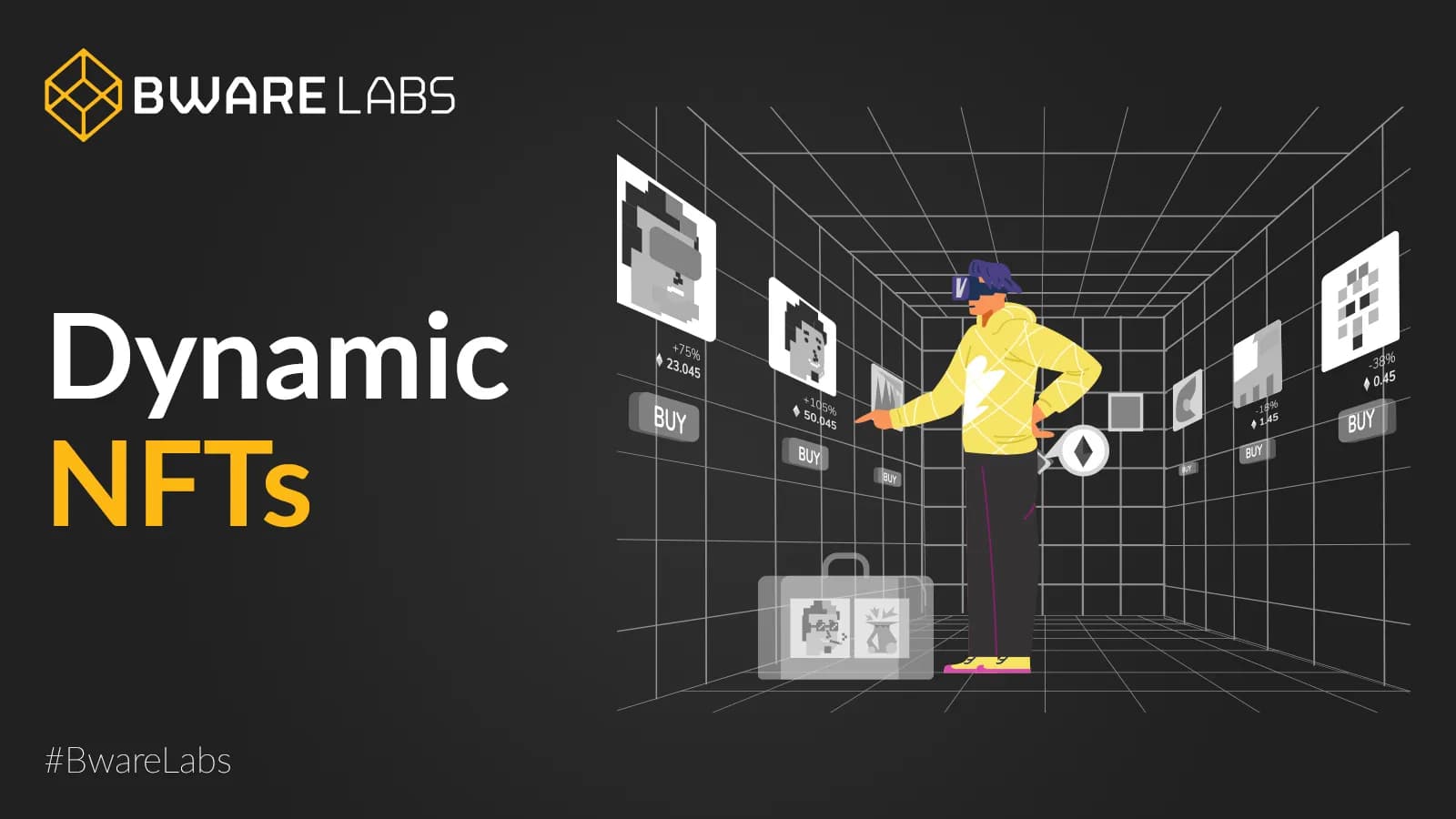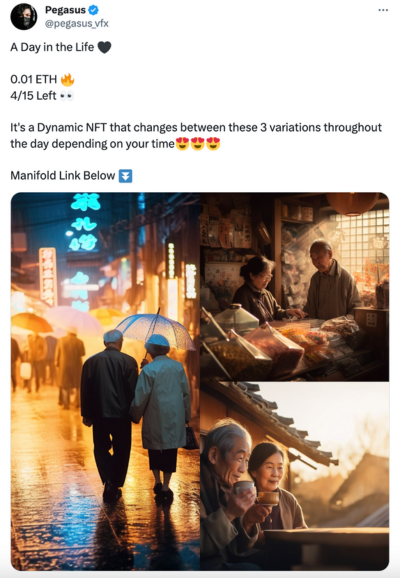
What Are Dynamic NFTs And Most Common Use Cases
Bware Labs Team
How are dynamic NFTs different from static ones and how can you use them? Learn how dynamic NFTs are revolutionizing digital art, gaming, and other industries.
Would you believe an NFT can help you become a more popular influencer or content creator if you link it with your social media account? If you think it’s a joke, dynamic NFTs will prove you’re wrong.
As one of the most prominent and flashy elements of the Web3 space, NFTs have continually emerged and evolved. Dynamic NFTs came as a natural step forward to support a wider adoption and development of NFT technology and new use cases.
Beyond artwork, dynamic NFTs are meant to create new levels of engagement and interactivity in the music and sports industry, gaming, real estate, and yes, even social media. You can turn your posts into digital assets that change their ranking level based on the number of likes, reposts, and comments. The higher your rank, the more options you have to access exclusive token-gated dApps, websites, and digital experiences.
Read below and learn all the details about dynamic NFTs, their benefits, future and current real-world use cases.
What is A Dynamic NFT?
A dynamic NFT (dNFT), also called a “living NFT” represents a new type of non-fungible token whose content or properties can be changed or updated based on pre-programmed instructions triggered by a smart contract.
Every NFT has its own metadata, which describes its characteristics. For a gaming NFT, metadata could include an avatar’s traits, like clothing accessories or strength level. With a dynamic NFT, when you mint an avatar for a Metaverse blockchain game, you can change your character’s stats, like maybe changing its physical representation when you reach a higher level in the game.
With NFT art, you can update its content or properties and make an NFT using a series of images instead of just one static image; you can rotate these images every 24 hours or once a week.

Changes in dynamic NFTs are possible through:
- on-chain events (information that is stored and processed directly on the blockchain; this data is publicly visible, and anyone within the network can access and check it);
- off-chain events (information stored outside the blockchain network, often in centralized databases or external systems).
*What’s not a dynamic NFT: a moving image like a GIF or a video cannot be considered a dynamic NFT. These can become an NFT, but only a static one. Dynamic NFTs only refer to an NFT that’s able to be altered after mint and if its change depends on external conditions.
Despite their “dynamic” characteristics, GIFs and videos remain in their original format.
How Does a Dynamic NFT Work?
When you create a dNFT, you define the rules within your smart contract’s code for when or how the NFT needs to change and which external events to track.
Oracles are the ones that connect blockchain networks to external systems, going through the following steps:
- oracles take information from real-world APIs
- they send this information to smart contracts
- the smart contract alters the dNFT’s metadata
- the dNFT changes its characteristics or behavior based on new information
How Is a Dynamic NFT Different from A Static NFT?
By design, NFTs are immutable, unique assets which, once minted on the blockchain, no one can change their metadata.
Even as time passes or certain events occur, these NFTs stay the same — the reason why they’re called static.
Here’s a clearer view of the differences between static and dynamic NFTs:

Common Use Cases of Dynamic NFTs
Some of the most common use cases of dNFTs include these fields:
- Gaming
So far, you could use NFTs as a receipt, proving your ownership for a character, weapon, skin, or any purchased item in a game. With dynamic NFTs, these assets level up, and you can program them to change based on your progress or achievements or even weather conditions. You can join game tournaments with other players who own dNFTs and exchange dNFT assets as a reward.
You’ll own all these items even if a game shuts down; you can still use or sell your NFTs in future new games.
- Digital art
With the help of dynamic NFTs, digital artists can make their art pieces even more unique. They can program NFTs so their artwork can change its background color every season or any way they wish based on external events or conditions. Additionally, to attract a wider audience or keep it engaged, artists can modify the NFT based on the audience’s interaction with the asset.
For example, an artistic NFT will display more design elements as it reaches a higher number of bids during an auction sale.
You can check Art Blocks as an example.
- Collectibles
Similar to gaming, collectibles pave new opportunities for collectors and investors to own rare and unique assets, particularly in arts and sports. For example, sports players launch NFTs whose avatars change along with their progress during a game or an entire season.
One example is Proof Collective from Moonbird.
- Real estate
Although currently it isn’t a real-life scenario, a dynamic NFT could represent a real estate property. The NFT can be programmed to update all the changes that were made to the property by taking the off-chain data from the town hall, for instance. This will allow potential buyers to see the history of the property, verify improvements within local jurisdiction, while property owners can authenticate proof of ownership.
- Fundraising
NFTs used for fundraising purposes aren’t a new concept. But dynamic NFTs programmed to mint when the fundraising sum reaches a certain amount or to unlock hidden or unique content make the entire concept more appealing to a wider public.
A few examples are:
- Regenerative Resources Co (RRC) — a project that kicked off in 2021 with the release of short films through a dynamic NFT. RRC has been making more picture frames available each time the NFT was resold. The project is still running until the movie’s final sequence will be released. With the collected funds, RRC will plant mangroves.
- Genomic NFT from Nebula Genomics — Harvard Medical School geneticist and professor George Church has been working on a tokenized, purchasable NFT of his entire genome. As one of the first human genomes ever sequenced, this will represent a unique event in science and human history.
These are only a few examples as dNFTs can find potential use cases in identity management, education, or travel.
Conclusion
In terms of engagement and interactivity, dynamic NFTs have no current match in the Web3 space. They’ll likely increase interest from users who may not have been interested in NFTs.
Yet, dynamic NFTs are nearly at an early stage and will likely transform and come up with new elements to support the increasing number of real-world use cases.
Until then, you can start your blockchain journey with Blast! Create and deploy smart contracts you can then use to mint and list NFTs.

